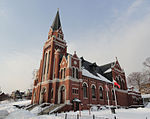Engine Company 6 Fire Station
Buildings and structures in Hartford, ConnecticutDefunct fire stations in ConnecticutFire stations completed in 1937Fire stations on the National Register of Historic Places in ConnecticutGovernment buildings completed in 1937 ... and 1 more
National Register of Historic Places in Hartford, Connecticut

The Engine Company 6 Fire Station is a former Hartford Fire Department firehouse located at 34 Huyshope Avenue in Hartford, Connecticut. Built in 1937, it is a well-preserved example of a Moderne style fire station, and served as such until 1984. The building was listed on the National Register of Historic Places on March 2, 1989. It now houses a homeless shelter.
Excerpt from the Wikipedia article Engine Company 6 Fire Station (License: CC BY-SA 3.0, Authors, Images).Engine Company 6 Fire Station
Huyshope Avenue, Hartford Downtown Hartford
Geographical coordinates (GPS) Address Nearby Places Show on map
Geographical coordinates (GPS)
| Latitude | Longitude |
|---|---|
| N 41.757222222222 ° | E -72.666388888889 ° |
Address
Huyshope Avenue 47
06106 Hartford, Downtown Hartford
Connecticut, United States
Open on Google Maps









